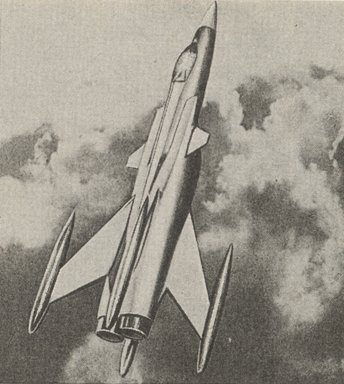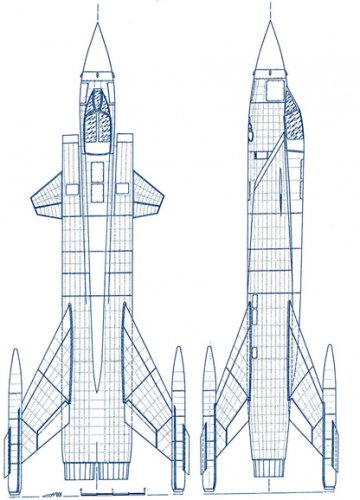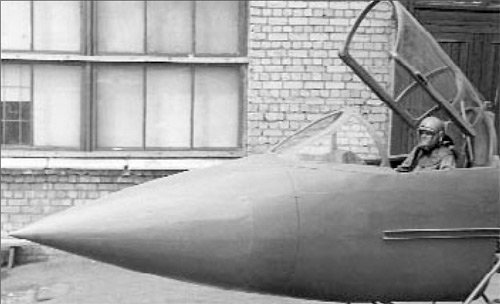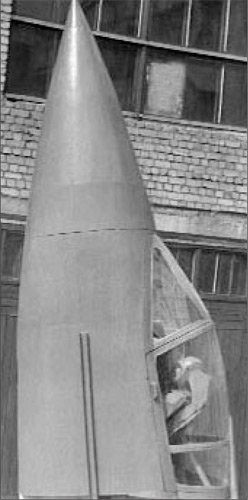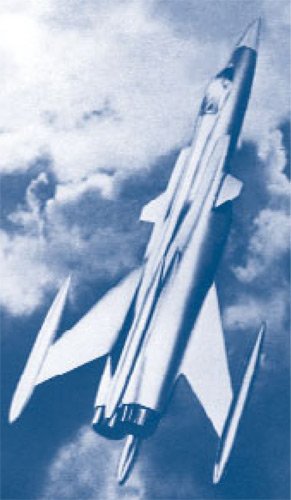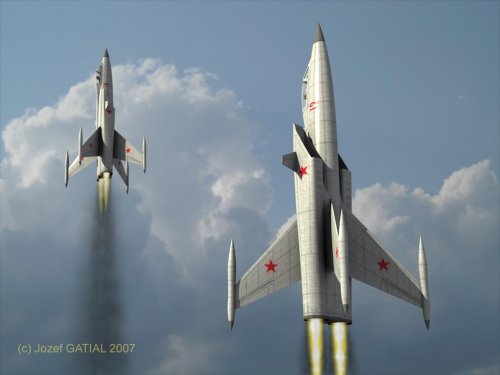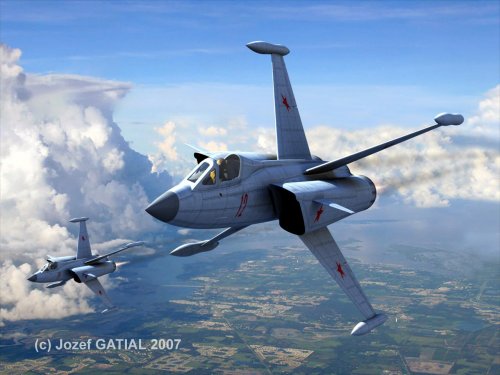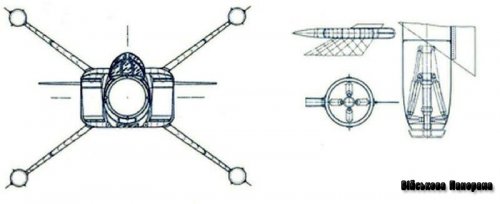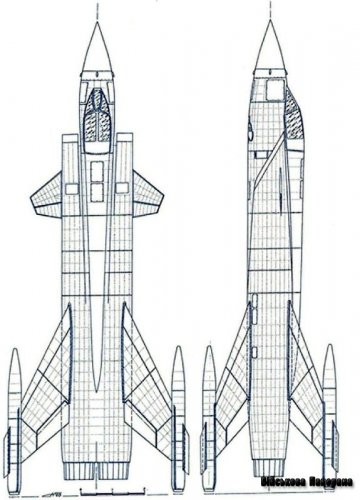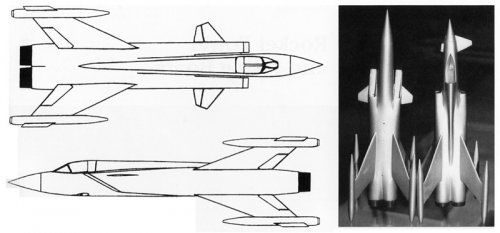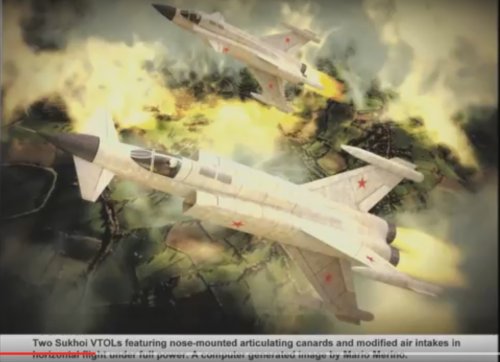You are using an out of date browser. It may not display this or other websites correctly.
You should upgrade or use an alternative browser.
You should upgrade or use an alternative browser.
Sukhoi Shkval Tailsitter Fighter
- Thread starter hesham
- Start date
- Joined
- 27 December 2005
- Messages
- 17,748
- Reaction score
- 26,422
Attachments
- Joined
- 11 March 2006
- Messages
- 8,625
- Reaction score
- 3,806
"How was it erected, if it landed horizontally?"
This was a problem, I think, that may have doomed the use of the tailsitter
concept. For this Sukhoi design, or for most other tailsitters like the Convair
XFY-1 Pogo, the Lockheed XFV-1 , or the SNECMA Coleopter, a "conventional"
landing would have meant, that there would have been no need for further thoughts
about erecting the aircraft to take-off attitude again ..
To bring home the aircraft with a faulty engine, developing much less thrust than normal,
would have been nearly impossible.
This was a problem, I think, that may have doomed the use of the tailsitter
concept. For this Sukhoi design, or for most other tailsitters like the Convair
XFY-1 Pogo, the Lockheed XFV-1 , or the SNECMA Coleopter, a "conventional"
landing would have meant, that there would have been no need for further thoughts
about erecting the aircraft to take-off attitude again ..
To bring home the aircraft with a faulty engine, developing much less thrust than normal,
would have been nearly impossible.
In doing a re-read of Soviet Secret Projects: Fighters since 1945, I read the segment on the Shkval tail-sitter and its origination came from a 'private organisation' within the Sukhoi OKB led by R G Martirosov to deal with "aircraft of an unorthodox and less conventional layout." I was wondering if there was any information on other creations from this Sukhoi 'Skunk Works?'
- Joined
- 1 April 2006
- Messages
- 11,394
- Reaction score
- 10,303
You got it rather wrong. It was an initiative group of designers, that gathered as volunteer group, working at projects at free hours after work or weekends (like it was with Ivashechkin's&Co. SPB - a far predecessor of Su-25 - later).dreamstar said:In doing a re-read of Soviet Secret Projects: Fighters since 1945, I read the segment on the Shkval tail-sitter and its origination came from a 'private organisation'
within the Sukhoi OKB led by R G Martirosov to deal with "aircraft of an unorthodox and less conventional layout."
I was wondering if there was any information on other creations from this Sukhoi 'Skunk Works?'
There was never a special, 'elite' ADP department at Sukhoi.
airrocket
Dreams To Reality
. I have seen drawings of what appears to be a MIG-25 or 31 without wings having four fins launching vertically. Any additional information of this MIG variant?
XP67_Moonbat
ACCESS: Top Secret
- Joined
- 16 January 2008
- Messages
- 2,271
- Reaction score
- 544
The cover of SOVIET SECRET PROJECTS: FIGHTERS. It was the Sukhoi Shkval project.
http://www.secretprojects.co.uk/forum/index.php/topic,5099.msg168137.html#msg168137
http://www.secretprojects.co.uk/forum/index.php/topic,5099.msg168137.html#msg168137
sounds like the sukhoi shkval featured on the cover of tony buttler & yefim gordons book soviet secret projects.
http://www.amazon.com/Soviet-Secret-Projects-Fighters-Since/dp/1857802217/ref=sr_1_12?s=books&ie=UTF8&qid=1361070458&sr=1-12&keywords=tony+buttler
http://www.amazon.com/Soviet-Secret-Projects-Fighters-Since/dp/1857802217/ref=sr_1_12?s=books&ie=UTF8&qid=1361070458&sr=1-12&keywords=tony+buttler
airrocket
Dreams To Reality
Sukhoi.....thanks that is it.... looks like I might be adding that book to my library.
airrocket
Dreams To Reality
What engines ?
Looks more MIG based in design by intake location like MIG 25 or 31?
Spec's ?
Looks more MIG based in design by intake location like MIG 25 or 31?
Spec's ?
I am kinda curious about the X wings. It seems to me an X-winged aircraft should be able to aerodynamically sustain more or less the same G force in any direction, pitch, yaw, or any combination.
Has anyone ever done any studies to see how pilots can handle 9G yaw?
It seems to me it to be a great advantage in a close dog fight if the fighter can instantly pull high G in any direction, and not have to roll the aircraft first to achieve the correct bank.
Has anyone ever done any studies to see how pilots can handle 9G yaw?
It seems to me it to be a great advantage in a close dog fight if the fighter can instantly pull high G in any direction, and not have to roll the aircraft first to achieve the correct bank.
- Joined
- 2 August 2006
- Messages
- 3,255
- Reaction score
- 1,527
chuck4 said:I am kinda curious about the X wings. It seems to me an X-winged aircraft should be able to aerodynamically sustain more or less the same G force in any direction, pitch, yaw, or any combination.
Has anyone ever done any studies to see how pilots can handle 9G yaw?
It seems to me it to be a great advantage in a close dog fight if the fighter can instantly pull high G in any direction, and not have to roll the aircraft first to achieve the correct bank.
It would unnecessarily add weight and the only time you want to yaw is for quick nose pointing for a snap shot. If you need a 9G yaw snapshot you've designed a horrendously poor aircraft. 9G yawing is what missiles are for, not aircraft. Also, if you want to be able to maneuver at high loads in any direction, that will be handled in the future by A2A UCAV's.
Trying to design a cockpit and a seat that could handle sustained 9G side loads on a pilot would be very limiting to the pilot. How do you move your arms on the flight controls if you are being pressed sideways by 9G's on one arm or the other? And if the side load was carried by the human body under his arms, I wouldn't be surprised if the pilot ended up with some fractured ribs, as the pilots body load is going to be distributed over much less area than a conventional seating configuration during normal orthogonal loading wrt to the velocity vector. It's simply a non-starter from the get go.
famvburg
I really should change my personal text
- Joined
- 24 July 2011
- Messages
- 386
- Reaction score
- 54
Stumbled upon this thread looking for info on the Shkval. Sharkit offers a kit he calls Shkval 2, based on the MiG-25. http://sharkit.com/sharkit/Shkval2/Shkval2.htm
- Joined
- 25 June 2009
- Messages
- 14,753
- Reaction score
- 6,151
athpilot said:Hm Shkval-2 ... seems to be a fake. :-\
My feeling exactly. I don't think it's good for the image of Sharkit to mix fake and real designs without a word of warning.
Vladimir
I really should change my personal text
- Joined
- 22 September 2015
- Messages
- 321
- Reaction score
- 53
Vladimir
I really should change my personal text
- Joined
- 22 September 2015
- Messages
- 321
- Reaction score
- 53
- Joined
- 26 May 2006
- Messages
- 34,908
- Reaction score
- 15,779
BestPlanes
ACCESS: Restricted
- Joined
- 1 November 2019
- Messages
- 3
- Reaction score
- 5
- Joined
- 27 December 2005
- Messages
- 17,748
- Reaction score
- 26,422
It was made up, is what it was.From Air Pictorial 9/1957,
here is an Info about Russian vertical takeoff aircraft similar to X-13,had been tested and
that means it had tailsitter shape,so I excluded Rafaelyants Turbolyot,and for Sikhoi Shkval,
it was from 1963,what was it ?.
- Joined
- 26 May 2006
- Messages
- 34,908
- Reaction score
- 15,779
It was made up, is what it was.From Air Pictorial 9/1957,
here is an Info about Russian vertical takeoff aircraft similar to X-13,had been tested and
that means it had tailsitter shape,so I excluded Rafaelyants Turbolyot,and for Sikhoi Shkval,
it was from 1963,what was it ?.
My dear Paul,
after check,I think it was Tysbin Tsi-1 VTOL Fighter ?.
The Soviets could not duplicate the construction technology of the Vigilante, made of Aluminum-Lithium alloy and Titanium.
The MiG-25 weighed 80,954 lb. (36,720 kg) because it was built in an 80 per cent nickel-steel alloy, with 11 per cent Aluminum and 9 per cent Titanium.
In 1963 it was not considered possible to build a VTOL version of the Foxbat that weighed less than 30 tons and the maximum thrust that could be obtained with the most advanced versions of the R-25 turbojet was 24,700 lbs. (11,189 kg) using afterburner.
It was expected that the Shkval would have to withstand 9G loads during combat and its structure should be reinforced to withstand impacts upon landing, it would have been necessary to further increase its structural weight.
The MiG-25 weighed 80,954 lb. (36,720 kg) because it was built in an 80 per cent nickel-steel alloy, with 11 per cent Aluminum and 9 per cent Titanium.
In 1963 it was not considered possible to build a VTOL version of the Foxbat that weighed less than 30 tons and the maximum thrust that could be obtained with the most advanced versions of the R-25 turbojet was 24,700 lbs. (11,189 kg) using afterburner.
It was expected that the Shkval would have to withstand 9G loads during combat and its structure should be reinforced to withstand impacts upon landing, it would have been necessary to further increase its structural weight.
Fake Soviet fighter.From Air Pictorial 9/1957,
here is an Info about Russian vertical takeoff aircraft similar to X-13,had been tested and that means it had tailsitter shape,so I excluded Rafaelyants Turbolyot,and for Sikhoi Shkval,it was from 1963,what was it ?.
In February 1953, Air Force magazine published the article "Vertical Take-off: Russia's Answer to the Global Bomber?”
According to author Charles W. Cain, the Soviet chief of staff thought that the MiG-15 climb rate was not enough to intercept the B-36 bombers.
But with the use of a VTOL rocket fighter, of the German Bachem Natter class, the interception time could be reduced to just two minutes.
The magazine also published two illustrations of the CZ-2B VTOL jet fighter, designed in 1947 at the Polish Technical Institute by the engineers Zarankiewicz and Wojciechowski, under the leadership of the Russian Dr. J.V. Stepanchev.
The CZ-2B was a tail-sitter with delta wing, dorsal/ventral air-intakes and three tailfins with shock-absorbers bumpers.
In 1947 the only Soviet turbojet powerful enough to power a VTOL fighter was the Lyulka TR-2 with 2,500 kg thrust and the CZ-2B had to be designed with a maximum take-off weight of just 4,415 lb. (2,000 kg), 42 ft. (12.8 m) wingspan, 54.2 ft. (16.5 m) length, 21.7 ft. (6.6 m) height and 450 sq. ft. (40.5 sq. m.) wings surface.
They are not believable figures, by comparison the Western designs that had been built using more advanced technologies weighed much more: The SNECMA C.450 Coléoptere 6,614 lb. (3,000 kg), the Convair XFY Pogo 16,250 lb. (7,371 kg), the Lockheed XFV Salmon 16,221 lb. (7,358 kg) and the Ryan X-13 Vertijet 7,200 lb. (3,272 kg).
The CZ-2B was expected to use two ribbon parachutes housed in the nose to perform vertical landings. It seems like an idea taken from the 1950 movie "Destination Moon" something that detracts from the credibility of the Air Force article.
The version published in 1955 in the color cover of CIELO magazine had several retro-rockets on the back of the fuselage, possibly to facilitate the landing.
In June 1955 LIFE published three new illustrations in which the plane lacked air intakes, probably the cartoonist McCoy thought it was a rocket spaceship.
According to the magazine the new fighter was already in mass production and it had been sighted in Korea by F-86 pilots.
In September 1957 Air Pictorial published: “A vertical take-off and landing turbojet-powered aircraft similar to the Ryan X-13 has been tested, and reports state that it has excellent low speed handling characteristics and a very high rate of climb.”
Attachments
-
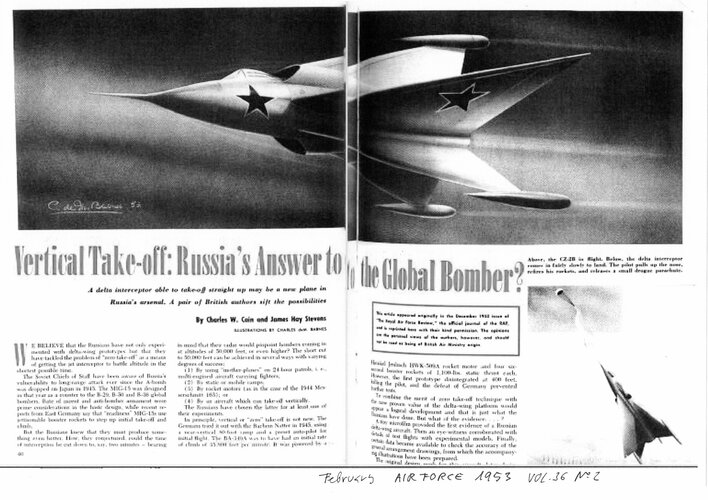 544.jpg1.8 MB · Views: 231
544.jpg1.8 MB · Views: 231 -
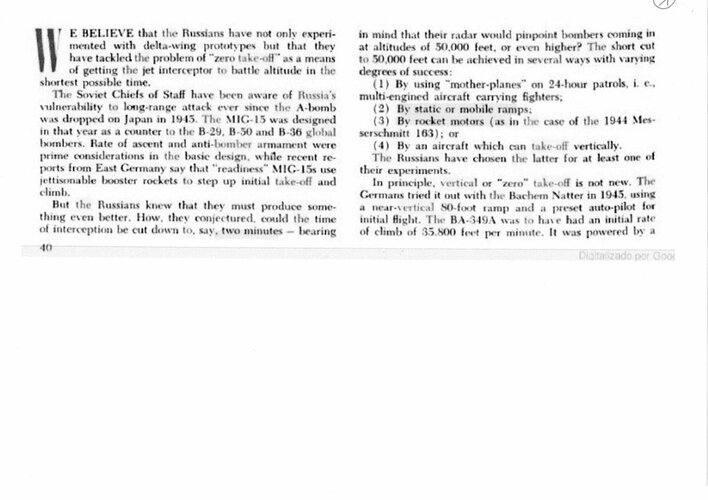 545.jpg1.1 MB · Views: 164
545.jpg1.1 MB · Views: 164 -
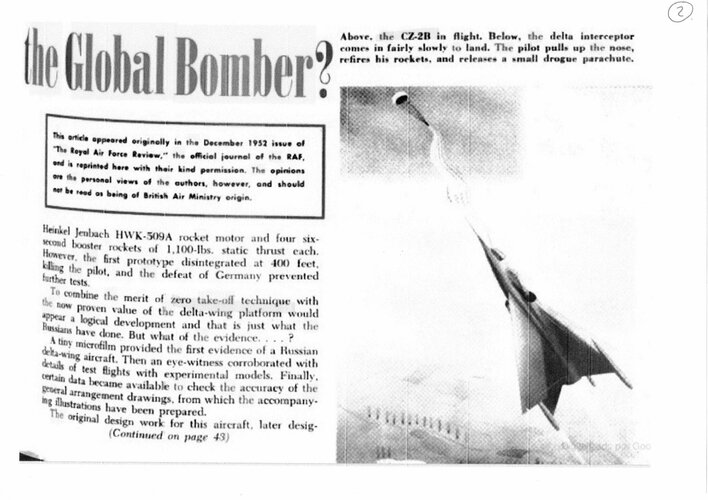 546.jpg1.7 MB · Views: 150
546.jpg1.7 MB · Views: 150 -
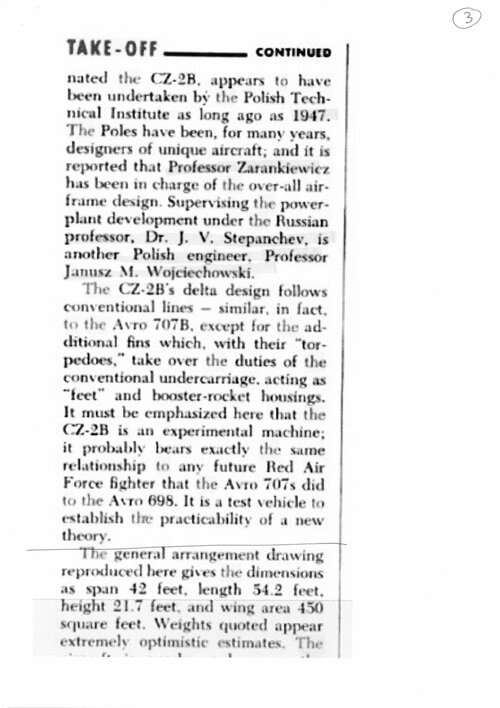 547.jpg1.4 MB · Views: 140
547.jpg1.4 MB · Views: 140 -
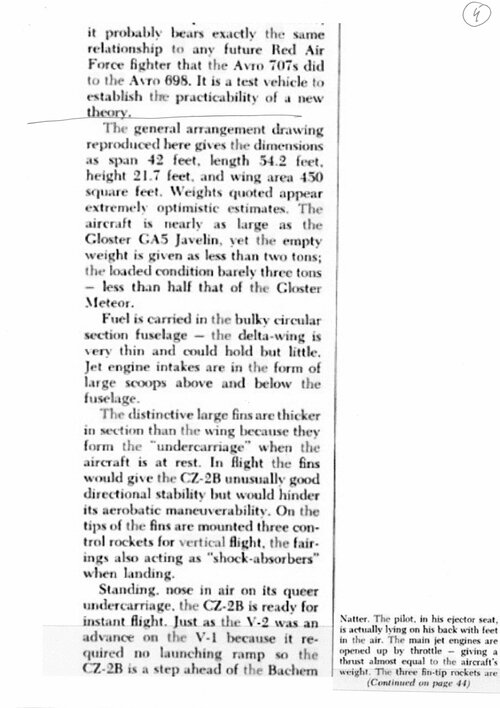 548.jpg1.4 MB · Views: 122
548.jpg1.4 MB · Views: 122 -
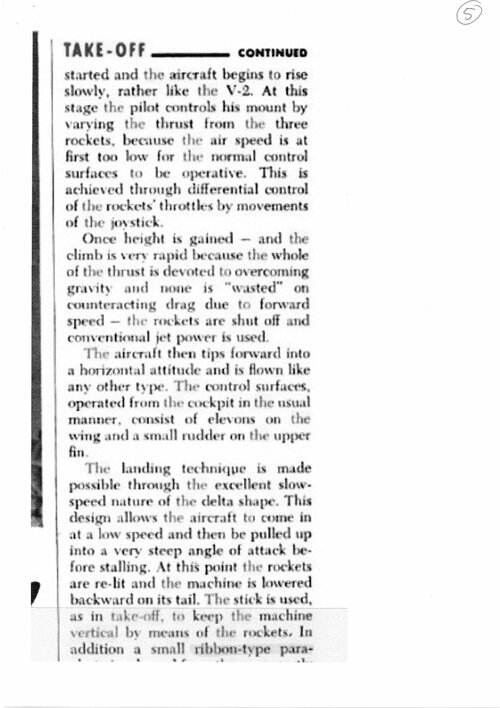 549.jpg1.4 MB · Views: 111
549.jpg1.4 MB · Views: 111 -
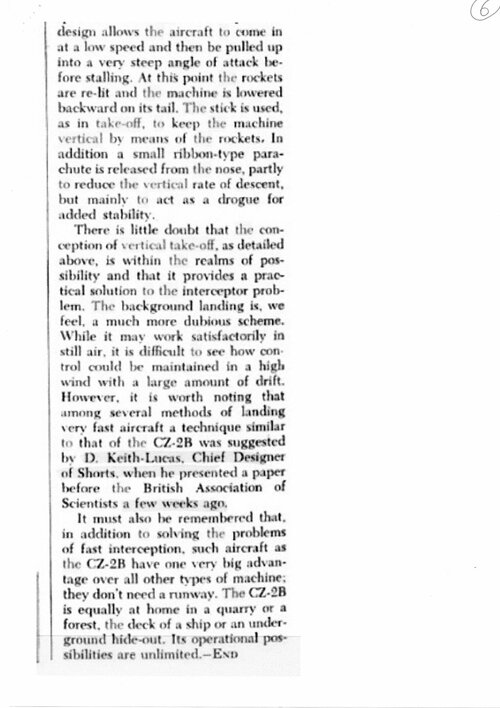 550.jpg1.3 MB · Views: 131
550.jpg1.3 MB · Views: 131 -
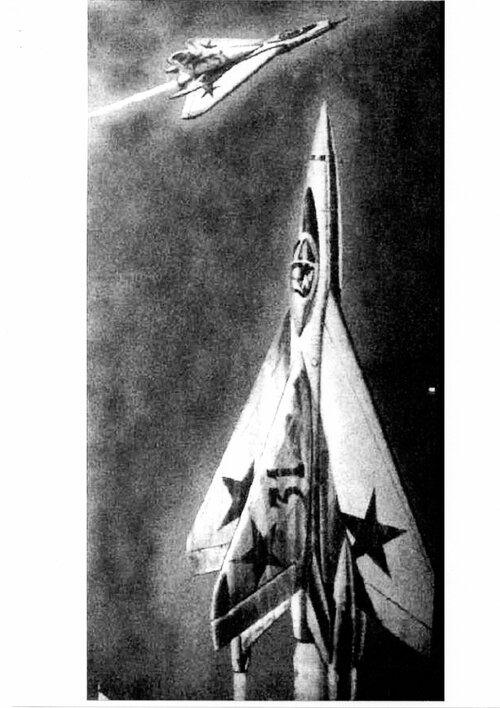 551.jpg1.8 MB · Views: 149
551.jpg1.8 MB · Views: 149 -
 552.jpg1.5 MB · Views: 153
552.jpg1.5 MB · Views: 153 -
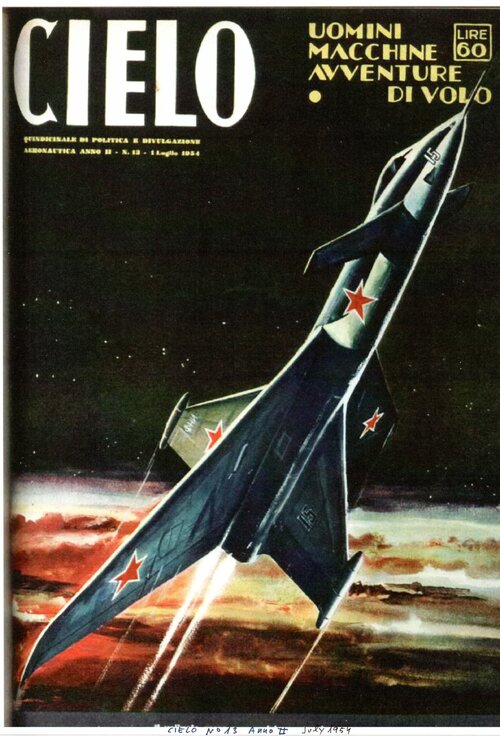 553.jpg2.6 MB · Views: 159
553.jpg2.6 MB · Views: 159 -
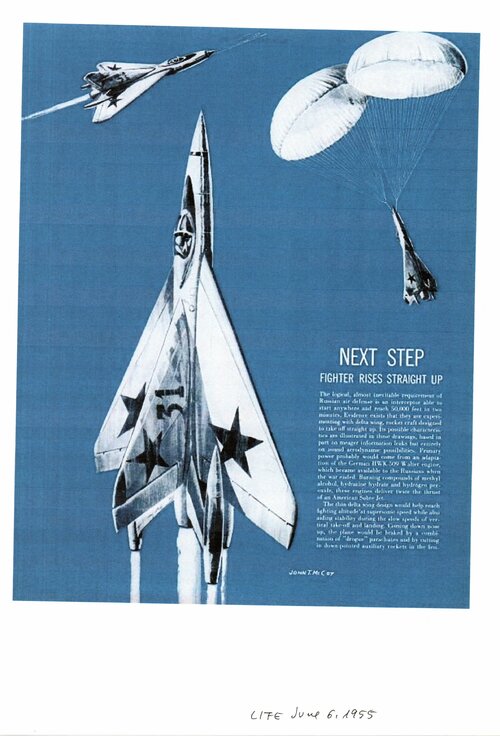 554.jpg2.2 MB · Views: 159
554.jpg2.2 MB · Views: 159 -
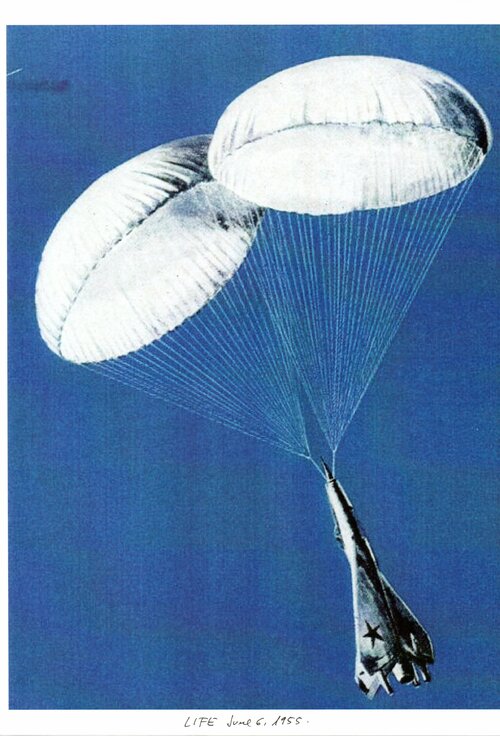 555.jpg2.3 MB · Views: 170
555.jpg2.3 MB · Views: 170
- Joined
- 26 May 2006
- Messages
- 34,908
- Reaction score
- 15,779
All of that is right my dear Justo,In September 1957 Air Pictorial published: “A vertical take-off and landing turbojet-powered aircraft similar to the Ryan X-13 has been tested, and reports state that it has excellent low speed handling characteristics and a very high rate of climb.”
except this on as I guess,why not they meant Tysbin Tsi-1 VTOL Fighter ?,
specially it was very closely to the description !.
I don't know that Tsybin project... should it have a rhomboid wing?All of that is right my dear Justo,In September 1957 Air Pictorial published: “A vertical take-off and landing turbojet-powered aircraft similar to the Ryan X-13 has been tested, and reports state that it has excellent low speed handling characteristics and a very high rate of climb.”
except this on as I guess,why not they meant Tysbin Tsi-1 VTOL Fighter ?,
specially it was very closely to the description !.
BestPlanes
ACCESS: Restricted
- Joined
- 1 November 2019
- Messages
- 3
- Reaction score
- 5
- Joined
- 27 December 2005
- Messages
- 17,748
- Reaction score
- 26,422
Never heard of a Tsybin Tsi-1 VTOL Fighter. There was Ts-1 but that wasn't VTOL.
- Joined
- 26 May 2006
- Messages
- 34,908
- Reaction score
- 15,779
How come my dear Paul,Never heard of a Tsybin Tsi-1 VTOL Fighter. There was Ts-1 but that wasn't VTOL.
you definitely have the book Unflown Wings,page 581.
A small quote from the source,and its drawing is very close to the fake
one which displayed by my dear Justo.
Attachments
Here's what I know about the Tsybin
In 1946 several wing planforms were wind tunnel tested at TsAGI as a result of which the OKB-256, under the leadership of Pavel Tsybin, developed three research airplanes with different wings with the same area.
The first prototype LL-1 was built by the Beresnev OKB with straight wings and wood/plywood construction.
It was flown, in glider configuration, by mid-1947 being towed to a launch altitude by a Tu-2.
The LL-1 made 30 high speed diving trials powered by one Kartukov PRD-1500 solid propellant rocket with 3,311 lb (1,500 kg) peak thrust.
The glider wings were attached to the fuselage on a dynamic suspension, which allowed to determine the pressure on the wing and tail at the approach to the critical Mach number.
A typical dive would start between 16,400-23,000 ft. and 45-60 degrees until at full speed it was levelled out and the rocket fired.
The airplane reached 656 mph (1,050 km/h-Mach 0.87) maximum speed.
At the end of the year the prototype was refitted with 30 degrees forward swept wings to become the LL-3.
According to some authors, the prototype made more than a hundred flights reaching 746 mph (1,200 km/h-Mach 0.97).
Effects of aero elastic divergence of the Duralumin wings were not noticed but the TsAGI recommending the use of swept back wings in the future Alekseyev 150 bomber and also that the Junkers EF 131 V1 prototype did not exceed Mach 0.75 during flight tests.
On July 31, 1947, this aircraft experienced several vibrations problems during the second flight and could not be flown in the Tushino air display planned for 18 August.
The project was cancelled on June 21, 1948.
A third Tsybin research plane, named LL-2, was planned to be built with 30 degrees swept back wings but the project was dropped in favour of the German DFS 346 transonic research rocket plane, designed to reach 1,250 mph (Mach 1.9).
Tsybin LL-1 technical data
Wingspan: 23.3 ft. (7.1 m), length: 29.4 ft. (8.98 m), height: 8 ft. (2.45 m), wing surface: 113.3 sq. ft. (10.2 sq. m), launch weight: 4,501 lb (2,039 kg).
Tsybin LL-3 technical data
Wingspan: 23.7 ft. (7.22 m), length: 29.4 ft. (8.98 m), height: 8 ft. (2.45 m), wing surface: 113.3 sq. ft. (10.2 sq. m), launch weight: 4,415 lb (2,000 kg).
In 1946 several wing planforms were wind tunnel tested at TsAGI as a result of which the OKB-256, under the leadership of Pavel Tsybin, developed three research airplanes with different wings with the same area.
The first prototype LL-1 was built by the Beresnev OKB with straight wings and wood/plywood construction.
It was flown, in glider configuration, by mid-1947 being towed to a launch altitude by a Tu-2.
The LL-1 made 30 high speed diving trials powered by one Kartukov PRD-1500 solid propellant rocket with 3,311 lb (1,500 kg) peak thrust.
The glider wings were attached to the fuselage on a dynamic suspension, which allowed to determine the pressure on the wing and tail at the approach to the critical Mach number.
A typical dive would start between 16,400-23,000 ft. and 45-60 degrees until at full speed it was levelled out and the rocket fired.
The airplane reached 656 mph (1,050 km/h-Mach 0.87) maximum speed.
At the end of the year the prototype was refitted with 30 degrees forward swept wings to become the LL-3.
According to some authors, the prototype made more than a hundred flights reaching 746 mph (1,200 km/h-Mach 0.97).
Effects of aero elastic divergence of the Duralumin wings were not noticed but the TsAGI recommending the use of swept back wings in the future Alekseyev 150 bomber and also that the Junkers EF 131 V1 prototype did not exceed Mach 0.75 during flight tests.
On July 31, 1947, this aircraft experienced several vibrations problems during the second flight and could not be flown in the Tushino air display planned for 18 August.
The project was cancelled on June 21, 1948.
A third Tsybin research plane, named LL-2, was planned to be built with 30 degrees swept back wings but the project was dropped in favour of the German DFS 346 transonic research rocket plane, designed to reach 1,250 mph (Mach 1.9).
Tsybin LL-1 technical data
Wingspan: 23.3 ft. (7.1 m), length: 29.4 ft. (8.98 m), height: 8 ft. (2.45 m), wing surface: 113.3 sq. ft. (10.2 sq. m), launch weight: 4,501 lb (2,039 kg).
Tsybin LL-3 technical data
Wingspan: 23.7 ft. (7.22 m), length: 29.4 ft. (8.98 m), height: 8 ft. (2.45 m), wing surface: 113.3 sq. ft. (10.2 sq. m), launch weight: 4,415 lb (2,000 kg).
Similar threads
-
-
VTOL Light-Weight Day Fighter studies, 1953-1957
- Started by overscan (PaulMM)
- Replies: 7
-
A question about the cockpit of the Goodyear GA-28A/B
- Started by Tim52413
- Replies: 1
-
-
Alleged Dassault VTOL tailsitter project
- Started by Jemiba
- Replies: 12

